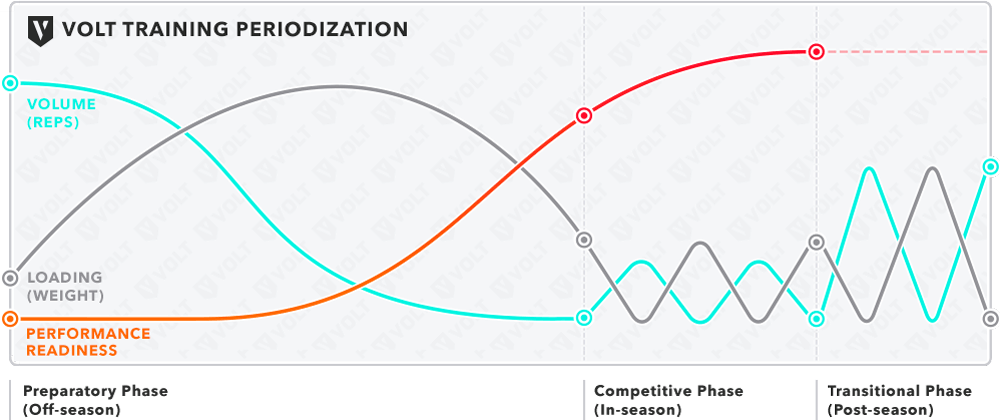Volt Training Philosophy: No Failure, No Exhaustion
/"Why did today's workout feel easy?"
"Why am I not super sweaty after a training session?"
"Why is the rest between exercises so long?"
As you begin implementing your team's Volt program, your athletes might come to you with questions about their training. In fact, we hear from many coaches whose athletes feel their Volt workouts aren't "challenging" or "tiring" enough. Volt programs are designed by CSCS-certified strength coaches to produce sport-specific training adaptations — but sometimes, strategic and intentional workouts can seem "too easy," especially for athletes used to "sweat equity" workout culture, which prizes hard work above all else.
Athletes accustomed to feeling 100% exhausted at the end of a workout are often surprised by Volt's scientific approach to sport performance — and even more surprised when it works. This article is intended to equip you with the "whys" behind Volt's training philosophy, so you can help educate your athletes and increase their buy-in to Volt.
Progressive Overload
Volt training is founded on the principle of progressive overload, meaning the training will progressively challenge athletes through incremental increases in intensity and/or volume over the course of each set and each week of a training block. The key word here is progressive, which indicates a scientific and methodical approach to overloading the body, rather than aggressive and random spikes. This progressive method enables the body to adapt to the demand of a specific movement over time while helping athletes avoid injury and plateaus in training. Progressive overload also helps prevent both intensity-induced (too heavy) and volume-induced (too many reps) overtraining.
Pro Tip: Volt uses patent-pending Smart Sets technology to fine-tune each athlete’s personalized loading recommendations, so athletes are challenged appropriately in every training session. Smart Sets asks athletes to rate the perceived difficulty of a set, then updates their next set in real time to optimize their training results.
No Failure
One of the most common training mistakes athletes make is training to failure — lifting until no more repetitions can be performed in a set. This type of training is not only dangerous, but also does NOT maximize performance in a given sport. Frequent training to failure does not prepare an athlete to succeed. Volt training is designed to enable athletes to successfully complete their sets with perfect form, to both mitigate the risk of injury during a workout and create a high standard of achievement in the weight room. Each rep should be executed with the best possible technique and quality, which is impossible to maintain when training to failure.
No Exhaustion
Gone are the days of measuring workout performance by the "puke factor" of a training session. Volt workouts are intentionally designed to NOT leave your athletes 100% exhausted, but instead to challenge athletes safely with an appropriate amount of fatigue. When an athlete nears the point of absolute exhaustion, technique inevitably breaks down and injury risk increases. Volt's goal is to keep your athletes fresh and ready to perform in the weight room and on the field — which they cannot do if they continually push too hard during training.
Rest Intervals
Specific rest intervals are prescribed between each set of movements, and sometimes they can feel "too long" to athletes. But these rest intervals have more to do with replenishing energy substrates than an athlete's perceived readiness to move to the next set. For example, Volt recommends a full 3 minutes of rest between sets of max-effort barbell movements (like heavy back squats). This is because the body is utilizing the ATP-CP energy system to provide fuel for demanding movements, and it takes 3-5 minutes for the body to replenish that system with enough fuel for the next set. So while your athletes may not feel tired enough to observe the full rest intervals, encourage them to do it anyway! We recommend athletes never sit while resting — instead, have them walk around, help spot another athlete, hydrate, mobilize, set up their next movement, or simply stand and refocus their mental energy to attack the next set.
The Takeaway
Athlete buy-in is key to the success of any program. Making sure your athletes understand the "whys" behind their Volt training can go a long way toward making your program successful, while building more trust between athlete and coach!
If you have any questions about Volt's training philosophy, please contact your designated CSCS-certified Strength Coach Consultant!
Not part of the Volt Family? Join over 1 million coaches and athletes using Volt's AI-powered training system. For more information, click here.
Learn more about Christye and read her other posts | @CoachChristye










